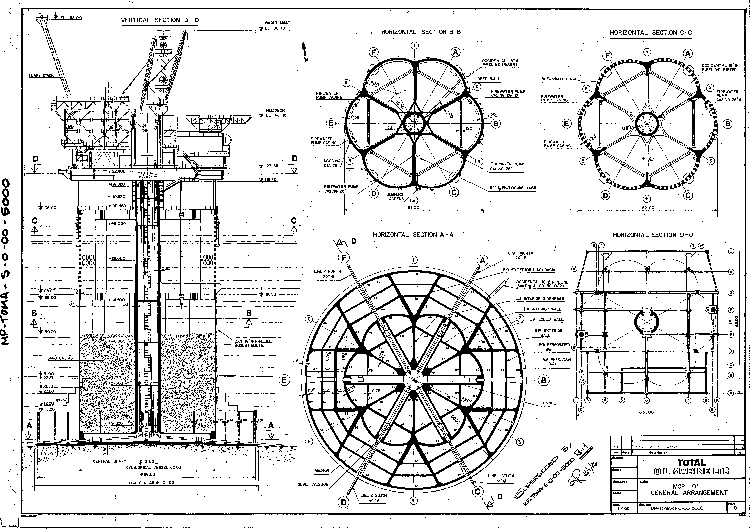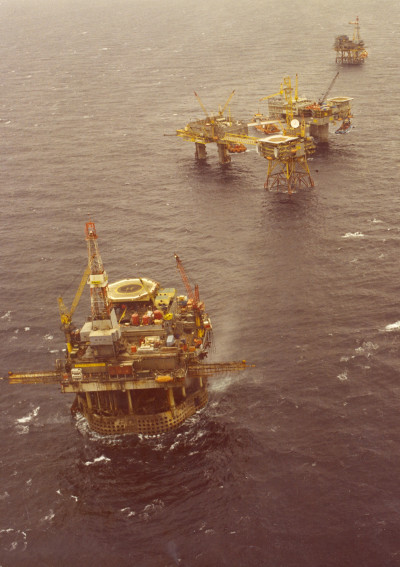Archives Hub feature for April 2015
The University of Aberdeen’s Special Collections Centre has a growing collection of archives relating to the UK offshore oil and gas industry, which has been centred in Aberdeen since the 1960s. The Capturing the Energy project, based at the University, is working with companies and organisations across the industry to ensure that historical records find their way to the archive to preserve a record of one of modern Britain’s most significant industries.
Frigg
One of the Oil & Gas Archive’s key collections is the Frigg UK archive, which was deposited by the operating company Total as part of a documentation project between 2006 and 2008.
The Frigg field was the world’s largest and deepest offshore gas field when it was discovered in 1971, straddling the international boundary between the Norwegian and British sectors of the North Sea. British and Norwegian companies involved agreed to develop and manage the field as a single entity operated by Total E&P Norge in Stavanger, Norway.

At its peak, 1800 men were working on the construction of five installations in the Frigg Field. There were two drilling and treatment platforms on the Norwegian side and three on the British side of the border: an accommodation platform for 120 people, plus additional treatment and drilling platforms. Bridges connected three of the platforms, crossing over the international boundary line.
An additional platform in the UK sector, MCP-01, formed part of the Frigg Transportation System (FTS) which transported gas from the field to the St Fergus terminal in Scotland. The FTS is formed of two 230 mile long pipelines, laid between 1974 and 1977, and MCP-01 switched gas between the two pipelines, compressed the gas entering the pipelines and was also used for the inspection and maintenance of the pipelines.
Archives

The documentation project was run by the Norwegian Petroleum Museum in Stavanger, in partnership with the Stavanger Regional Archives and the University of Aberdeen who both took in archive material relating to Frigg. The University collected material relating to MCP-01, the Frigg Transportation System and the St Fergus terminal.
The Frigg UK collection contains over 1,500 individual items, including engineering drawings, technical manuals, operational records, staff magazines, photographs, and film and video footage. Oral history recordings provide a uniquely personal view of how the arrival of North Sea gas shaped people’s lives. There are runs of engineering, administrative and publicity records, showing the development of technology and changes in corporate policy.
Significance of Frigg

Location map showing MCP-01 and the Frigg Field.
At its peak in the late 1970s and early 1980s, Frigg supplied Britain with a third of its gas requirements, contributing to Britain being self-sufficient in energy for a time. More widely, the industry as a whole generated many jobs across the UK and in Aberdeen City and Shire in particular: in 2012 the offshore oil and gas industry was estimated to provide employment for 440,000 people across the whole country. The construction, development and operation of the Frigg platforms, FTS and St Fergus provided employment for many people locally in Aberdeenshire and across the UK and Norway. In the early 1980s MCP-01 also housed the first women to work on a British installation in the North Sea.

Frigg’s position in the northern North Sea between the Norwegian and British sectors, and the depth of the field meant that many technological innovations and a landmark international agreement, the 1976 Frigg Treaty, were needed to develop the field. World records for speed and depth were set with the construction and installation of the FTS pipelines. As the first international field to be exploited in Europe, Frigg became the model on which later collaborative agreements and operations were based.
Although the platforms on the Frigg field have now been decommissioned and removed, the Frigg pipelines continue to be used to transport gas from other fields to St Fergus, which continues to supply around 20% of the UK’s energy requirements.
The field is also the first example of a documentation project for the UK sector of the North Sea, and Capturing the Energy hope to employ a similar methodology to capture important records about other significant fields in the industry’s history.
Frigg on the Archives Hub
The collection description is available on the Archives Hub and is also available on the University of Aberdeen’s own catalogue.
More information about the Frigg project and Capturing the Energy are available on the respective project websites: http://www.capturing-the-energy.org.uk/ and http://www.abdn.ac.uk/historic/energyarchive/, and you can get further details about the University of Aberdeen’s oil and gas collections in this factsheet: https://www.abdn.ac.uk/library/documents/guides/hcol/qghcol011.pdf
Katy Johnson
Project Development Officer, Capturing the Energy
All images copyright the University of Aberdeen, and reproduced with the kind permission of the copyright holder.
